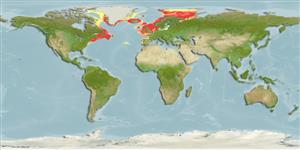Environment: milieu / climate zone / depth range / distribution range
экология
морской демерсальный; мигрирует в океане (Ref. 51243); пределы глубины 1 - 600 m (Ref. 58426), usually 18 - 110 m (Ref. 7135). Temperate; 82°N - 40°N, 75°W - 61°E (Ref. 119696)
Northeast Atlantic: Spitsbergen southward to White Sea, Scandinavian coasts, North Sea, the British Isles, to the Northen part of Bay of Biscaye, also Iceland and south-eastern coasts of Greenland (Ref.. 57932). Northwest Atlantic: southern Labrador in Canada and western Greenland to Cape Cod in Massachusetts, USA; rarely to New Jersey, USA (Ref. 7251). Elsewhere in the Baltic Sea and Mediterranean from Ref. 57932 should be regarded as questionable, as stray at most, until original reports are cheked (see Ref. 119696).
Length at first maturity / Size / Вес / Возраст
Maturity: Lm 55.0, range 50 - 60 cm
Max length : 150 cm TL самец/пол неопределен; (Ref. 7251); наибольший вес (опубликованные данные): 23.6 kg (Ref. 40637)
Ground color usually greyish-green but almost black or reddish -brown. Body with 10-15 transverse, dark bars extended to the dorsal fin (Ref. 35388).
Inhabit rocky bottoms, sometimes over sand or mud, from 1-500 m (Ref. 9988). Benthic (Ref. 58426). Feeds on fishes (Ref. 58426), hard-shelled mollusks, crabs, lobsters, sea urchins and other echinoderms. Solitary in habit (Ref. 9988). Marketed fresh and frozen; eaten steamed, fried, broiled, boiled, microwaved and baked (Ref. 9988).
Males guard a clutch of eggs right up to the time of hatching (Ref. 6407). During brood protection, the male hardly feeds (Ref. 6407).
Barsukov, V.V., 1986. Anarhichadidae. p. 1113-1116. In P.J.P. Whitehead, M.-L. Bauchot, J.-C. Hureau, J. Nielsen and E. Tortonese (eds.) Fishes of the North-eastern Atlantic and the Mediterranean. volume 3. UNESCO, Paris. (Ref. 4694)
Статус Красного Списка МСОП (Ref. 130435: Version 2024-2)
Угроза для людей
Harmless
Использование человеком
рыболовство: важный объект промысла; аквакультура (рыбоводство): экспериментальный; объект спортивного рыболовства: да; аквариум: общественные аквариумы
дополнительная информация
инструменты
Специальные отчеты
Скачать в формате XML
ресурсы в Интернет
Estimates based on models
Preferred temperature (Ref.
123201): 0.8 - 12.1, mean 7.8 °C (based on 1910 cells).
Phylogenetic diversity index (Ref.
82804): PD
50 = 0.5938 [Uniqueness, from 0.5 = low to 2.0 = high].
Bayesian length-weight: a=0.00407 (0.00305 - 0.00544), b=3.19 (3.11 - 3.27), in cm total length, based on LWR estimates for this species (Ref.
93245).
Trophic level (Ref.
69278): 3.6 ±0.0 se; based on diet studies.
устойчивость к внешним воздействиям (Ref.
120179): низкий, минимальное время удвоения популяции 4.5-14 лет (K=0.04-0.1; tm=6-7; Fec=12,740-25,000).
Prior r = 0.40, 95% CL = 0.26 - 0.60, Based on 3 full stock assessments.
Fishing Vulnerability (Ref.
59153): High to very high vulnerability (69 of 100).
Climate Vulnerability (Ref.
125649): Moderate vulnerability (38 of 100).
Nutrients (Ref.
124155): Calcium = 8.54 [4.15, 34.43] mg/100g; Iron = 0.178 [0.082, 0.506] mg/100g; Protein = 17.1 [15.1, 19.7] %; Omega3 = 0.376 [0.216, 0.633] g/100g; Selenium = 38.1 [13.6, 104.4] μg/100g; VitaminA = 6.68 [2.05, 21.68] μg/100g; Zinc = 0.675 [0.265, 1.313] mg/100g (wet weight); based on
nutrient studies.
